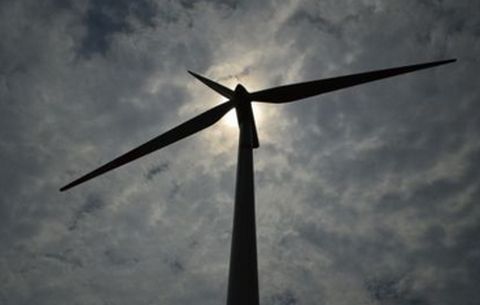By: Lisa Sorg
January 12, 2023
 Around 6 o’clock on the evening of Friday, Dec. 30, when anyone who could be was mentally checked out for the holidays, the North Carolina Utilities Commission dropped one of its most important rulings of the last decade: The 137-page Carbon Plan, the commission's directive to Duke Energy to drastically reduce its carbon dioxide emissions and to do its part in thwarting a planetary crisis.
Around 6 o’clock on the evening of Friday, Dec. 30, when anyone who could be was mentally checked out for the holidays, the North Carolina Utilities Commission dropped one of its most important rulings of the last decade: The 137-page Carbon Plan, the commission's directive to Duke Energy to drastically reduce its carbon dioxide emissions and to do its part in thwarting a planetary crisis.
However, many clean energy and environmental advocates quickly decried the plan as deferential to the utility. “Tragically, the NC Utilities Commission went along with Duke Energy’s massive, climate-wrecking fracked gas expansion,” Jim Warren, executive director of NC WARN, Duke’s perennial nemesis, wrote. “The commission also seemed to go along with Duke’s request to greatly limit new solar projects indefinitely pending billions in new – and likely controversial – transmission projects.”
These projects include small modular nuclear reactors, nascent hydrogen power technology and additional natural gas resources.

This table shows the proposed amount of megawatt hours for various energy types. Combined turbine and combined cycle use natural gas. (Chart: Utilities Commission Carbon Plan)
The plan is a requirement under House Bill 951, which Gov. Roy Cooper signed into law in October 2021. It directs the utilities commission to “take all reasonable steps” to reduce carbon dioxide emissions from Duke Energy’s electric generating facilities. The plan sets a goal of 70% reduction in carbon emissions by 2030 – just seven years from now. And by 2050, Duke should have achieved carbon neutrality.
The commission has the flexibility to delay these benchmarks by up to two years or longer if nuclear or wind power requires more time to be built or to maintain the reliability of the grid.
But the planet is out of runway. Globally, the last eight years have been the warmest on record, according to data released this week by the European Union's Copernicus Climate Change Service. Levels of carbon dioxide and methane continue to increase. “For both gases these are the highest concentrations from the satellite record,” the service reported, “and by including other records, the highest levels for over 2 million years for carbon dioxide and over 800,000 years for methane.”
And three of Duke Energy’s proposals prepared in cooperation with Public Staff – the citizens’ representative body that advises the commission – would blow past the 2030 deadline. “While the Commission correctly decided not to decide now to extend the 2030 compliance requirement,” wrote the Southern Environmental Law Center, which represented three clean energy groups in the proceedings, “it adopted the near-term actions proposed by Duke, which are based almost entirely on plans that miss that deadline.”
The Carbon Plan contains other loopholes the size of the Antarctic ozone layer. Environmental justice, for instance, gets short shrift, with just four paragraphs devoted to the issue at the end of the document, as if an epilogue.
Environmental injustice is also baked into the rate disparities between Duke Energy Progress and Duke Energy Carolinas. Although Duke Energy owns both, the cost of electricity is “substantially higher” – by 19% – in Duke Energy Progress territory than Duke Energy Carolina, the report reads.
Put another way, a household served by DEP that uses 1,000 kilowatt hours per month pays $125.94, while a household in DEC using the same amount of energy pays $106.23.
The DEP service area encompasses 36 entire counties, of which 21 are designated as Tier 1, by the state Department of Commerce as “most distressed” economically. Most DEP territory lies along and east of I-95.
In comparison, of the 31 counties wholly in DEC territory, just six are Tier 1.
(DEP shares coverage with DEC in another dozen counties; three of which are most distressed.)
“The rate difference has increased consistently since Duke and Progress merged in 2012,” the commission wrote in the plan. “This is in part because Duke Energy Progress has more solar and needed transmission and distribution upgrades.”
To address the rate disparity, the utilities commission directed that Duke plan to merge its two systems. This would also spread the costs of carbon reduction and new investments over a larger customer base.
Because of its geography – flat expanses of land – DEP territory will have most of the new solar projects, and customers there “will bear a disproportionate share of the costs to achieve statewide compliance,” the commission wrote.
Duke is scheduled to present merger plans by its next interim Carbon Plan filing, no later than September of this year.
Here is an overview of some of the energy sources, both fossil fuels and renewable power, that Duke will continue to employ in the coming years:
Natural gas: Bridge fuel or planetary assassin?
The role of natural gas is “one of the most significant resource planning decisions in this proceeding,” the commission wrote.
However, methane, the main component in natural gas, is a major driver of climate change. But methane is not accounted for in the plan. That is by design: House Bill 951 omitted any constraints on methane or natural gas. For its part, Duke countered in the plan that methane and carbon dioxide “are distinct chemical compounds and had the legislature wanted to include methane they would have done so.”
Delaying new natural gas facilities would limit the utility's ability to retire existing coal units, Duke claims. The postponement would reportedly increase carbon emissions by 2 million tons for just one delayed unit.
While the commission did approve natural gas as part of its Carbon Plan, it cautioned this doesn’t mean it’s “approving the construction of a particular generating facility.”
In previous commission meetings and filings, Duke’s Modeling and Near-Term Actions Panel said natural gas would help “maintain reliability and quality of service.” Yet as North Carolinians now know, several natural gas and coal-fired power plants failed during last month’s cold snap, as instrumentation lines froze. To reduce the immense strain not only on the state grid, but the entire Eastern Interconnection, Duke had to inflict rolling blackouts on hundreds of thousands of customers on Christmas Eve.
There are also limitations on natural gas pipelines. Duke and Dominion canceled the Atlantic Coast Pipeline in 2020, citing enormous cost overruns and successful legal challenges to the project.
The Mountain Valley Pipeline, which is owned by a consortium of companies unrelated to Duke, is similarly stalled in Virginia, in part because of hundreds of environmental violations, thus jeopardizing its extension into North Carolina.
Duke is assuming no natural gas will be available from the MVP extension, according to the plan. Even if that extension is built, it’s uncertain whether the gas can reach Duke Energy Carolinas territory.
The cost of natural gas is skyrocketing, according to the US Energy Information Administration. And Duke modeled its prices before Russia invaded Ukraine, which constricted supply. The dollar figures are “now significantly higher than Duke’s worst case scenario in its Carbon Plan proposal,” the NC Attorney General’s Office wrote.
[infobox color="#bfbfbf" textcolor="#000000"]Upcoming dates of interest:
Duke Energy Progress rate increase hearings. The utility is requesting a 17.7% hike. All hearings start at 7 p.m.
* Monday, March 6 – Haywood County Courthouse, 285 N. Main St., Waynesville
* Tuesday, March 13 – Person County Courthouse, 105 S. Main St., Roxboro
* Wednesday, March 14 – Dobbs Building, 430 N. Salisbury St., Raleigh
* Tuesday, March 20 – Greene County Courthouse, 301 N. Greene St., Snow Hill
* Wednesday, March 21 – Robeson County Courthouse, 500 N. Elm St., Lumberton
Duke is scheduled to file its interim Carbon Plan/Integrated Resource Plan no later than Sept. 1, 2023.
The Utilities Commission’s next installment of its approved Carbon Plan is due by Dec. 31, 2024. [/infobox]
Here comes the sun -- but it's underwhelming
There is a limited amount of carbon-free (and methane-free) energy. Fortunately, North Carolina has a lot of it: the sun.
When combined with battery storage – allowing Duke to tap into the energy when the sun isn’t shining – solar is the cleanest form of power available in the state.
The commission approved Duke’s proposed near-term plan, limiting new solar to 3,100 megawatts through 2024, the most the utility claims it can interconnect to its system over the next five years. (To expedite solar interconnection would require Duke to work at 2.5 times the maximum rate it has done in a single year.)
Alternative proposals were more ambitious and, critics of the plan say, attainable.
The Clean Power Suppliers Association wrote that 5,400 megawatts -- far more than Duke's proposal -- is necessary to meet the 2030 goal. By lowballing the amount, “the Commission has made it extremely difficult” to achieve that target, CPSA wrote.
However, the public staff contended that that figure was unrealistic because of Duke’s transmission limits and costs. The staff contended “there must be an orderly transition from fossil fuel resources to renewable resources” and faults the Clean Power Suppliers Association and its contracted modeling” for not factoring in greater costs.
Read about some of the transmission challenges that confront North Carolina and the nation here, here and here.
Unlike Iowa and Texas, where thousands of wind turbines dot their flat landscapes, North Carolina has just two onshore farms: A 208-megawatt facility in Perquimans and Pasquotank counties owned by Amazon and the planned 189-megawatt facility in Chowan County, known as Timbermill. Both are in PJM territory, a regional transmission organization, and outside of Duke’s service area.
(A previous 18-month state moratorium on wind energy ended in December 2018. Trumpeted by former Sen. Harry Brown, a coastal Republican, the moratorium delayed the Timbermill project, and derailed progress on developing this renewable resource.)
It’s unlikely that any onshore facility would be built in Duke’s territory until at least 2029, and even then there are hurdles to clear. First, Carteret County has the greatest onshore wind potential, but it also lies within military flight paths, which complicates turbine siting. State law prohibits turbines on mountain ridges, so most blustery western regions are also off-limits.
Duke also has transmission constraints in parts of eastern North Carolina. That bottleneck is already limiting the amount of solar that can be passed on to other parts of the state. To accommodate wind power, Duke would have to significantly ramp up its transmission lines.
For off-shore wind, the prospects are better, although these are long-term plans.
In 2017 Avangrid leased federal waters 27 miles offshore of Kitty Hawk, where it plans to build a 2,500-megawatt farm. Transmission requires the installation of undersea cables, and the current route burrows beneath the Pamlico Sound, which is likely a deal breaker. In that case, Avangrid would have to connect onshore at Virginia Beach, adding 100 miles and $350 million to the cost.
President Biden revoked the Trump administration’s 10-year moratorium on offshore wind leasing in the Southeast, including North Carolina. After the temporary ban was lifted, Duke Energy Renewables Wind successfully bid $155 million for 55,000 acres off Carolina Long Beach in Brunswick County. Total Energies, a French company, won a separate lease in the area.
Duke has to provide a site assessment to federal officials by June, with a construction and operations plan due in late 2026 or mid-2027.
Considering the eight to 10 years typically required for an offshore wind farm to begin commercial operation, the utilities commission determined that this is a long-term solution, but not a near-term one.
The nuclear option
Duke is asking the Nuclear Regulatory Commission to extend its license for the existing nuclear plants in North Carolina: Brunswick, Shearon Harris and McGuire.
The utility is also investigating the feasibility of small modular nuclear reactors. Small nuclear reactors are about a third of the size of a typical nuclear power plant. They are housed underground and can be built more quickly and cheaply than traditional reactors.
An early version of House Bill 951 allowed Duke to incur as much as $50 million for an early site permit from the NRC. That provision was later stripped from the measure.
However, none of these small reactors currently operate in the U.S. NuScale, which builds the reactors, plans to deliver its first one to Utah in 2027. It’s not expected to go online until 2029. Even in its infancy that project has already come in well over budget — from $3 billion to $6 billion, according to a 2020 article in Scientific American.
Opponents also question their safety, especially in areas prone to flooding and earthquakes, as well as the disposal of nuclear waste.
Scientific American also reported that the NRC itself had safety concerns. One engineer discussed “boron dilution,” which means “that even if a reactor is shut down, fission reactions could restart and begin a dangerous power increase.”
Some clean energy advocates also opposed this technology in the Carbon Plan because it is “unproven and expensive, and will generate nuclear waste.”
Even Duke acknowledged these reactors are “not a mature technology and none is commercially operating.” To ramp one up by 2032 is an “aggressive schedule,” the plan reads.
Who pays for the Carbon Plan?
Duke wants to pass costs of the Carbon Plan along to ratepayers for its initial project development work for the following projects: new nuclear facilities, offshore wind, and pumped hydroelectric power. Current state law allows this early cost recovery only for nuclear plants. (It’s known as CWIP: Construction Work in Progress.)
Duke warned that without some money upfront, it “may not pursue some resources.”
The utility has ample money to pay its top people. CEO Lynn Good raked in nearly $81.5 million between 2017 and 2021, according to a report released this week by the Energy and Policy Institute, a national watchdog group.
Duke’s pricing models did not include hefty tax cuts for energy producers that were included in the Inflation Reduction Act. Congress passed, and President Biden signed into law, the act in August, after Duke had completed its modeling.
Other federal actions could also alter costs and the overall marketplace. For example, the EPA is scheduled to propose its revised Clean Power Plan in March. The agency also issued a proposal in November that would further limit methane emissions from natural gas operations.
That said, the utilities commission did approve Duke's proposal to spend roughly $72 million to investigate nuclear power possibilities.
But in general, the commission declined to rule on “cost reasonableness and the prudence of Carbon Plan execution costs until formally presented at a hearing,” it wrote. “This is not a preapproval of cost recovery.”
Duke, not surprisingly, supported the Carbon Plan, as the utility received much of what it requested from the commission.
“We believe this is a constructive outcome that advances our clean energy transition, supporting a diverse, ‘all of the above’ approach that is essential for long-term resource planning,” the utility said in a prepared statement.
Clean energy advocates, though, felt deflated by the timidity of the plan, calling the order “disappointing.”
Joel Porter, policy director of CleanAIRE NC, said that while the plan includes “many commendable provisions,” it will likely miss the 2030 targets as set out in House Bill 951. “We have to be serious about lowering emissions,” Porter said.
That point was underscored by NOAA this week. The climate crisis is increasing the chances of extreme weather, such as floods, wildfires and heatwaves. In the first 10 days of 2023, the California coast was drowned in relentless floods. And in Europe, seven countries reported all-time record highs, where mid-winter has been as warm as summer.








